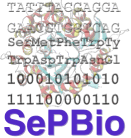| Statistics References Contact Links Help ArchDB Help ArchKI |  |
Home ArchDB90 ArchDB40 ArchKI Query ArchDB Query ArchKI |
|
Help Page
Introduction:
Conformational clusters and consensus sequences have been derived by computational analysis for kinase loops from SCOP database. Loops have been classified into five types (alpha-alpha, beta-beta links, beta-beta hairpins, alpha-beta and beta-alpha) according to the secondary structures they embrace.
Geometry
Four parameters were defined to describe the protein loop geometry. An axis for an alpha or beta secondary structure was defined based on the shortest of the principal moments of inertia of that structure. The geometry of each motif was defined by four internal co-ordinates. M1 and M2 are the axis vectors of the secondary structure. Loop geometry is defined by four parameters (The angles are in greek font in the figure).
- D - distance between alpha helix or beta strand which brace the loop.
- Theta - the packing angle, i.e, the angle between axis M1 and M2.
- Delta - the hoist angle, i.e., the angle between axis M1 and vector of D.
- Rho - the meridian angle, i.e., the angle between axis M2 and the plane.

Loop classification table:
Five tables of loop classes were constructed based on the types of loop. The table headers are explained as follows:
- Class: -The class of loops defined by the loop clustering in the paper, e.g., aa{b}aa is a loop that links two alpha helices with residues of beta Ramachandran angle in the loop.
- CN: -Class number, a numerical number for the definition of the class, e.g., 1.1.1 and so on.
- NR: -Number of residues in the loop. This number may vary in the same loop class.
- RMSD(Å): -Root Mean Square Deviation of the superposed loops and their bracing secondary structure. It is used to quantify agreement but not for clustering. To calculate the RMSD all residues included in the multiple sequences alignment are taken into account (see "Alignment length").
- Consensus: -Sequence Consensus within the loop class. Capital letters for conserved residues, such as G - Glycine, D - Aspatic acid. p for polar residues [D, E, H, N, Q, R, S, T, Y]; h for non-polar residues [A, C, F, G, I, L, M, P, V, W, Y]. Tyr (Y) is assigned for both polar and non-polar residues. X denotes no sequence consensus.
Ramanchandran Angles:
Clustering of loop subclasses is based on the Ramanchandran phi/psi angles and loop geometry. A 9x9 matrix of phi/psi angle is defined as shown in the following table. The codes are explained in the table legend.
b b b p o M e e e b b b p o M M e e b b b p . l l s e a a a T . l l g N N a a a . U l g N N a a a . U g g N I a a a . G G G I e F F F o e e e e b b b p o e e e e
+180 0 psi -180
-180 0 +180 phi
- a: alpha helix
- l: left handed alpha helix
- b: beta strand
- p: beta prolin
- g: gamma
- e: epsilon
- l/g: bridge region between left handed helix and gamma
(written as 'v' in loops multiple alignment)
- b/p: bridge region between beta strand and beta prolin
(written as 'x'in loops multiple alignment
Pattern:
Unweighted aminoacid frequencies were calculated for each position. Then, aminoacids were grouped into predefined sets. If the sum of individual frequencies for a given set was equal o greater than 75% and lower than 90%, then such aminoacids are shown between brakets. If the sum of individual frequencies was equal or greater than 90%, then shuch aminoacids are shown between square brakets. Note that only the aminoacids present at that given position are shown, and not the full set. Bracing secondary structures were included in motif calculation.
Conservation degree:
Position specific conservation degree was calculated with AL2CO (Pei J. & Grishin N., Bioinformatics 2001). The options used were independent-count method for frequencies calculation and sum-of-pairs method (using a BLOSUM62 matrix) for conservation calculation. Bracing secondary structures were included in conservation calculation.
Functional Residues
Functional annotation of residues was classified in four categories:Three different approaches were applied to identify functional residues of the loops of the sub-classes:
- ATP interaction: for residues involved on ATP binding/interaction.
- Substrate binding: for residues involved in substrate interaction/binding with the exception of ATP
- Ion interaction: for residues involved in ion interaction/binding of ions needed for the catalytic mechanism
- Catalytic: involved in reaction, the stabilization of a transition state or the activation of substrates.
- Residues found within a cut-off distance of 6┼ from an heteroatom, ligand, inhibitor, cofactor or complex partner molecule (protein or DNA), with the exception of D2O or crystallization buffer molecules.
- Residues identified by functional information from ACTSITE and SITE records in the RCSB protein data bank.
- Residues identified by the functional annotation collected from the literature and assigned to specific motifs of kinases.
Functional Subclasses
We considered loop subclasses as functional subclasses, where there is a meaningful conservation of functional residues in the loops of the cluster, and more than 50% of loops belong to the same SCOP superfamily.
Rasmol Interactive Picture:
Pictures of all loop subclasses were generated by superimposing four loops randomly choosen in each class. When subclasses contained less than four loops, all loops were included in the picture.
[ Configuring your browser for the RasMol option (UNIX) ]
RASMOL Mouse Buttons
- Left - Rotate (X and Y)
- Right - Move
- Shift+Left - Zoom
- Shift+Right - Rotate (Z)
ZOOM
Up: Zoom Out (smaller)
Down: Zoom In (bigger)
Chime Interactive Picture:
Pictures were obtained the same way as RasMol Interactive Pictures
[ Download Chime plug-in (Windows or Mac) ]

| 
|